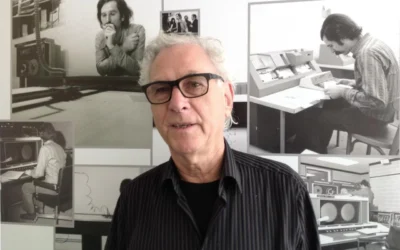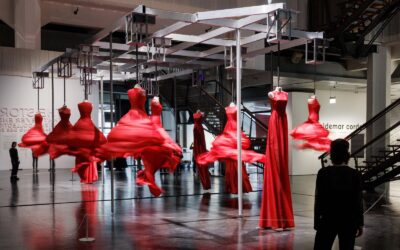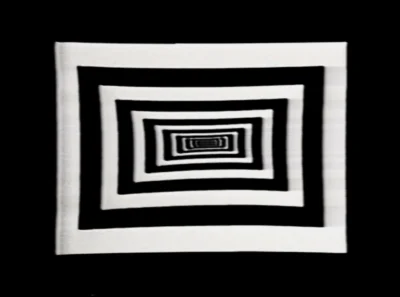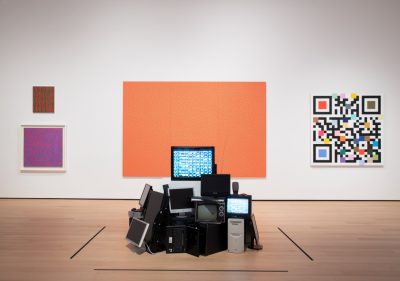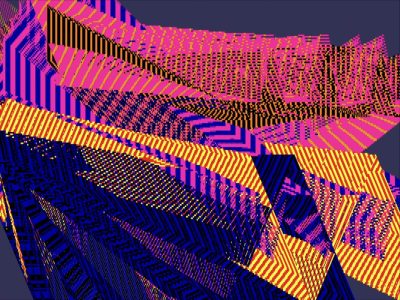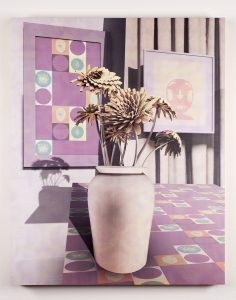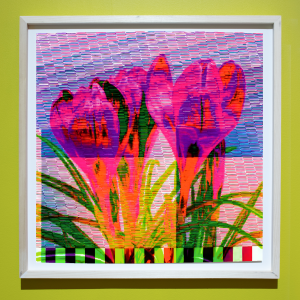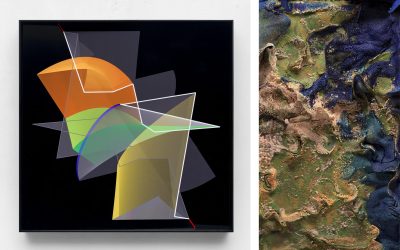Manfred Mohr has been producing paintings, drawings, wall reliefs, and films using computers and algorithms since 1968. His fifth solo show at bitforms gallery, Artificiata II includes works from this new series alongside historic works, some of which have never been exhibited.

Reception: Sunday, November 8, 6 – 8 PM
Gallery Hours: Wednesday – Saturday, 11 AM – 6 PM & Sunday 12 – 6 PM
Manfred Mohr has been producing paintings, drawings, wall reliefs, and films using computers and algorithms since 1968. His fifth solo show at bitforms gallery, Artificiata II includes works from this new series alongside historic works, some of which have never been exhibited.
A leader in software-based and generative art, Mohr’s singular body of work made with computers spans nearly five decades. Trained as both a jazz musician and fine artist, Mohr’s discovery of German philosopher Max Bense’s writing on information aesthetics in the early 1960s radically transformed his artistic thinking. His abstract expressionist work shifted to geometric abstraction, a profound change in an artistic climate that reproached rationality. Still, Mohr sought to achieve the pairing of rationality and expressiveness he first recognized in music: Though musical notation is logical and rule-based, music itself is purely abstract in its form.
Upon meeting French computer musician and composer Pierre Barbaud in 1967, Mohr was introduced to algorithmic music. Fundamentally, an algorithm is a set of instructions, and Mohr realized that he could invent a set of rules within his artistic practice. Using software as his medium, Mohr created a visual language based on the cube: if software is sheet music, the cube is its notation. While abstraction had previously been achieved through geometry or gestural mark-making, Mohr’s instruction-based conceptual work yields surprising results within a parametric framework. Already by 1969, Mohr had programmed his first computer drawings, and by 1971, he had a solo exhibition at the Musée d’Art Moderne in Paris where he demonstrated his process. First executed as plotter ink drawings, Mohr’s oeuvre now consists of paintings, drawings, artist books, sculptures, films, and computer animations.
Also in 1969, Mohr published his first visual artist book, Artificiata I (Edition Agentzia, Paris), comprising his last artwork drawn by hand. At the time, he proposed to create a second Artificiata book based on algorithms, calculated and drawn by a computer. Around 2012, Mohr’s visual research developed a strong relationship to the visual structure of musical scores, similar to the Artificiata of 1969. He decided to call his new body of work Artificiata II, and at the same time created a visual book with the same title. Published in 2014, Artificiata II (OEI Editör, Stockholm) is the visual poetry book of computer drawings, exactly as Mohr had imagined it forty-four years earlier.
Given the breadth of this exhibition, bitforms gallery has produced a document available online, detailing the algorithms used to generate each work or phase of works on display. An exhibition catalogue with the most recent works from Mohr’s Artificiata II phase—including Baseline, Projections and Dimensions, Parity, and Traces—has also been published.
BIOGRAPHY
Manfred Mohr is a leader within the field of software-based art. Co-founder of the “Art et Informatique” seminar in 1968 at Vincennes University in Paris, he discovered Professor Max Bense’s writing on information aesthetics in the early 1960s. These texts radically changed Mohr’s artistic thinking, and within a few years, his art transformed from abstract expressionism to computer-generated algorithmic geometry. Encouraged by the computer music composer Pierre Barbaud, whom he met in 1967, Mohr programmed his first computer drawings in 1969. His first major museum exhibition, Une esthétique programmée, took place in 1971 at the Musée d’Art Moderne de la Ville de Paris. It has since become known historically as the first solo show in a museum of works entirely calculated and drawn by a digital computer. During the exhibition, Mohr demonstrated his process of drawing his computer-generated imagery using a Benson flatbed plotter for the first time in public. Mohr’s pieces have been based on the logical structure of cubes and hypercubes—including the lines, planes, and relationships among them—since 1973.
Recently the subject of retrospective at ZKM, Karlsruhe, Mohr’s work is collected by the Centre Pompidou, Paris; Joseph Albers Museum, Bottrop; Ludwig Museum, Cologne; Victoria and Albert Museum, London; Mary and Leigh Block Museum of Art; Wilhelm-Hack-Museum, Ludwigshafen; Kunstmuseum Stuttgart; Stedelijk Museum, Amsterdam; Museum Kulturspeicher, Würzburg; Kunsthalle Bremen; Musée d’Art Moderne et Contemporain, Strasbourg; Daimler Contemporary, Berlin; Musée d’Art Contemporain, Montreal; McCrory Collection, New York; and Esther Grether Collection, Basel. Solo exhibitions and retrospectives of his work include ARC – Musée d’Art Moderne de la ville de Paris; ZKM, Karlsruhe; Art Basel, Switzerland; Joseph Albers Museum, Bottrop; Wilhelm-Hack-Museum, Ludwigshafen; Museum for Concrete Art, Ingolstadt; Kunsthalle Bremen; Museum im Kulturspeicher, Würzburg; and Grazyna Kulczyk Foundation, Poznan. Mohr’s work has also been part of group exhibitions at Fundacion Banco Santander, Madrid; ZKM, Karlsruhe; MoMA, New York ; Centre Pompidou, Paris; Museum Ritter, Waldenbuch; Museo Nacional Centro de Reina Sofia, Madrid; MoCA, Los Angeles; National Museum of Modern Art, Tokyo; SFMOMA, San Francisco; Musée d’Art Contemporain de Montreal, Montréal; Muzeum Sztuki Lodz, Poland; Neue Nationalgalerie, Berlin; MoMA PS1, New York; Leo Castelli Gallery, New York; and Galerie Paul Facchetti, both in Paris and Zürich. His work will be included in the forthcoming exhibition Electronic Superhighway at the Whitechapel Gallery, London, opening in January 2016.
Mohr is the recipient of an ACM SIGGRAPH Distinguished Artist Award for Lifetime Achievement in Digital Art; Golden Nica from Ars Electronica; the Camille Graesser-Preis, Zurich; D.velop Digital Art Award; and a New York Foundation for the Arts Fellowship.
Additional Information
Alongside works from Mohr’s Arificiata II phase (2012-15), other works in the exhibition demonstrate the variegated scope of Mohr’s oeuvre working with computers. The small room of historic works at the beginning of the exhibition contextualize Mohr’s recent Artificiata II:
From the Hard Edge phase (1966-1969) of work, Bild-1967 Zeichnung A (1967) is exemplary of Mohr’s geometric abstraction prior to generating work with a computer. This phase introduces geometry and constructibility (but not yet the computer) into his work. In a subjective selection process, geometric elements influenced by electronic and other technical signs are created and distributed over the entire pictorial surface. They are mobile signs, meaning they are exchangeable signs. Since all signs (forms) are surrounded by a pictorial force, they create–in their juxtaposition–a network of abstract visual tension.
A logical and automatic construction of pictures is introduced in Mohr’s Early Algorithms phase (1969-1973). It is during this period that algorithms—simply understood as a set of rules—are used to produce images. Mohr’s consequent thinking is rendered visible through self-authored computer programs. The resulting drawings were realized by a computer controlled drawing machine (plotter). With a choice of different line characteristics, an alphabet of arbitrary generated elements is created. Individual algorithms are invented for each work from which all forms and structures are solely generated. The algorithms are built from a selection of imposed and random principles, which Mohr refers to as “aesthetical-filters.” P-018-mf_11, 14, 20, 21 (1969), P-026-A (1970), and P-028 Tape 102 (1970) are examples of work from this period.
During Mohr’s Cubic Limit phases, he introduced the cube as a fixed system with which signs are generated. In the first part of this phase (1972-1976), an alphabet of signs is created from the twelve lines of a cube. In some works, statistics and rotation are used in the algorithm to generate signs. In others, combinatorial, logical, and additive operators generate the global and local structures of the images.
Cubic Limit (1973-1974) is a 16 mm film from this period, based on the logic of the cube. This form would become the basis of his practice from 1971 onwards. The film presents geometric abstraction that was output serially as an animation, using instructions that Mohr wrote with the FORTRAN programming language. During Mohr’s seminal 1971 exhibition Une Esthetique Programmée at the Musée d’art Moderne in Paris, he met the CEO of C.G.M (La Companie Generale de Micromatique), a data storage and preservation company, which specialized in microfilm. Mohr was invited to experiment on their brand new machine, the DATAGRAPHIX 4460, to make computer animations. He gladly accepted, and during the next four years made several short computer films. According to Mohr, “It was a very painful experience since the process was very slow and the turnover dragged out over many months.” Rendered digitally and then transferred to an analogue medium, each frame was drawn in high resolution, with a light beam directly from the computer onto 16 mm film.
P-169 (1974) is from the second phase of Cubic Limit (1976-1978), during which Mohr divided the cube into two parts by one of the Cartesian planes, or along a specific point on the coordinate plane. For each image the two partitions contain independent rotations of a cube. They are projected into two dimensions and clipped by a square window (the projection of a cube at 0,0,0 degrees). By rotating both parts of these cubes in small but different increments, long sequences of images are developed. This work has never before been exhibited in the United States. P-202-A (1977) is also from this phase.
P-224-E (1978-1979) and P-231 (1978-1979), from Mohr’s Dimensions phase (1978-1979), are based on the four-dimensional hypercube. This is when the “diagonal-path” of the hypercube is first introduced in Mohr’s practice: A diagonal-path is the connection of two such diametric points through the network of edges of this complex structure, and there are twenty-four diagonal-paths for each of the eight diagonals. For these works, among the others from this period, the graph of a hypercube is the basic generator of signs. This graph is a two-dimensional representation of the hypercube, indicating relationships between points, lines, squares, and cubes inherent in this structure. A global structure is generated either by combinatorially selecting lines from the cube or by showing connecting paths between two given diagonally opposite points on the graph, which are also diagonals. A four-dimensional hypercube has eight pairs of diagonally opposite points.
P-360-F {FF} (1984) is from Mohr’s Divisibilty II phase (1984-1986) of work, in which a molecular-like growth is created with a cube divided into four sections by a horizontal and a vertical cut, or “four-cut.” Here, the four-cut is the seed, and growth results from algorithms of graph patterns deciding which “out-lines” (shapes) of the quadrants created in the preceding generation will be used to produce the four-cut of the next generation.
P-460a77-3-6 (1989) is an early study on the structure of the 6D hypercube. Random edges are chosen from this structure and rendered as black or grey lines. The square support is a visual reference to the zero rotation of the hypercube. Mohr’s Line Cluster phase (1989-1990) is based on the 5-dimensional hypercube, a structure built from a set of eighty lines. A subset of twenty lines, containing four lines from each “dimensional-direction” are chosen from this structure. Each dimensional-direction therefore consists of four parallel lines, represented by three thin lines and one thick line, drawn in a given 5-dimensional rotation.
Mohr’s Laserglyphs phase (1991-1992) is based on the six-dimensional hypercube. This geometrically defined structure has thirty-two diagonals. The two endpoints of each diagonal lie diametrically opposite in the structure. A diagonal-path is the connection of two such diametric points through the network of edges of this complex structure. In a 6D hypercube, each of these thirty-two diagonals have 720 different diagonal-paths. For each Laserglyphs piece, a random selection of four diagonal-paths from this repertoire of 23040 (32×720) possible paths is made. The 2D dimensional projection of such groups of four are cut out of a metal plate by a laser to form a relief, such as in P-486-Q (1992). P-480/010110 (1992) shows the 720 diagonal-paths between between two diagonally opposite points in the 6D structure.
P-495-2 (1994-1995) is from Mohr’s Counterpoint phase (1993-1995). In this phase, two diagonal-paths through the 6D hypercube are chosen with the same method as in Laserglyphs (1990-1993). Each work consists of one thin black line and one thick grey line drawn on canvas. The line width is inversely proportional to the decrease in color intensity from black to grey. To visually maintain the inherent connectivity only lines which have at least one point in common within the structure can be chosen. Both lines have a visual relationship comparable to the counterpoint of a succession of sounds in music. For each work, the picture format is a result of the size and location of the two diagonal-paths in relationship to one another.
P-512a_1 (1996) is from Mohr’s Half Planes phase (1995-1997) of work, which is also based on the 6D hypercube. A random selection of two diagonal-paths from this alphabet of signs provides the building blocks for each work from this period. Here, the diagonal-paths are represented by thick white lines. The vector pairs which complete the quadrilaterals are represented by thin black lines, while the quadrilaterals are colored in grey to create the shape of the painting.
In 1999, Mohr made his first generative works. And after working for over three decades in black and white, Mohr’s space.color phase (1999-2003) introduces color. As Mohr’s work progressively became more complex, he was forced to reconsider the use of a binary system (black and white). Color, with its greater spectrum, was more adequate in visually expressing this work. Adding color to his work conveys the spatial relationships, which is not based on color theory; instead, the colors should be seen as random elements. Through their differentiation, the complexity and spatial ambiguity that is essential to Mohr’s work emerges. Works from this period are made with pigment ink on paper, such as P-671 b (1999-2003). This phase of works is also based on the 6-dimensional hypercube.
The phase of work space.color.motion (2002-2004) uses the same computer program as space.color, updated to run on all computer platforms, including PCs. Mohr’s self-built PCs execute the 6D animation program, with each installation using a unique set of parameters which determines the sub-structure and color set, as in and P-777_B (2002). Each time the program is restarted, it picks a new set of 6D random angles and increments based on the present time and date. This results in “unique” images which never repeat and are always surprising.
In the work from Mohr’s Aritficiata II phase (2012-2015), a diagonal-path from a hypercube, randomly chosen between eleven and fifteen dimensions, is drawn. A diagonal-path is a multiple-segmented line where each change of direction indicates the passage through a single dimension. Horizontal lines are attached to the line at each change of dimension, that is, the horizontal lines are drawn through the y-value of each vertex of the diagonal path when it is projected into 2D. The spaces between the horizontal lines on either side (left or right) of the diagonal-path are filled with distinct sets of randomly chosen colors. The same procedure also calculates lines and colors in the vertical direction through the x-value of each vertex. The vertical lines are not drawn, but the resulting color sets are retained. This procedure creates four color sets from which three are randomly chosen to construct the resulting image. By overlaying the color sets successively, unpredictable constellations appear. The color spaces and horizontal lines move with the structure when the diagonal path (white line) is in slow motion (rotating in hyper-dimensional space and then projected into 2D), and can be observed in his real-time computer animation works. The following works are from programs within Mohr’s Artificiata II phase:
P1611_5220 (2012-2013) is from the Baseline program written during Mohr’s Artificiata II phase. The animation algorithm of P1622 contains random variations of speed and suites of stills, adding a musical rhythm to this work. The work on canvas is therefore an instant from this animation.
The works that comprise P1650_B (2014) are from the Projections and Dimensions program written during Mohr’s Artificiata II phase. The animation P1660 shows all the 2D projections of a randomly chosen n-dimensional diagonal-path between 2D and 13D in a cyclic mode. Similar to the rules in twelve-tone music, each dimension has to be selected once before the same dimension can appear again. Program P1650 shows, on paper, a complete set of all the 2D projections of a n-dimensional diagonal-path between 2D and 13D.
P1682_166 and P1682_1239 (both 2014) are from the Parity – fracturing n-dimensional diagonal paths program written during Mohr’s Artificiata II phase. The works within the P1682 series show the fracturing of a diagonal-path into even and odd numbered lines. The algorithm also relates the attachment of a diagonal-path to its horizontal lines.
P2200_1539, P2200_1930, P2200_4570, P2202_18311, and P2202_27447 (all 2014-2015) are generated from the Traces – Capturing the history of n-dimensional rotations program written during Mohr’s Artificiata II phase. In Program P2200, the thick white line show a rotated n-dimensional diagonal-path projected into 2D and the color lines show the history of that movement restricted to the 2D rectangular space. The algorithm also relates the attachment of a diagonal-path to its horizontal lines.
The gallery is closed for install until June 24 for the opening of Tree_Line by Zancan.
